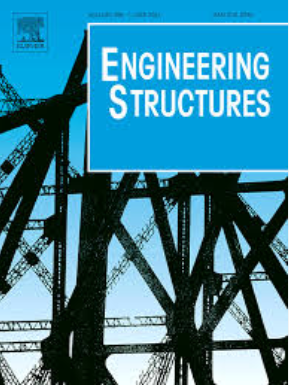Seismic performance prediction and interpretation of RC bridges under vehicle-bridge interaction: From VBI system simulation to ensemble learning surrogate models
IF 6.4
1区 工程技术
Q1 ENGINEERING, CIVIL
引用次数: 0
Abstract
To accurately predict the dynamic response of vehicle-bridge interaction (VBI) systems under seismic excitations, this study proposes a framework based on LightGBM (LGBM) for dynamic response prediction. The framework is enhanced with Bayesian optimization and interpretability analysis for model improvement and feature understanding, through thousands of nonlinear time - history analyses on a typical Chinese RC T-beam bridge, a comprehensive VBI model is established. It accounts for vehicle dynamic response on uneven bridge surfaces and the impact of random traffic loads on bridge response. For the non - stationary distribution of random traffic loads and traffic data growth, the study uses the generalized extreme value distribution to model the extreme values of stationary vehicle loads in each time interval. This discretizes the continuous stochastic process into a combination of stationary processes in the time domain, enabling non - stationary evaluation of vehicle load effects. Results indicate that the proposed LGBM model achieves superior accuracy in predicting six key dynamic response, with R² values exceeding 92 %, significantly outperforming traditional models such as RF, GBDT, and SVM. This demonstrates higher predictive accuracy and computational efficiency, providing a reliable tool for effectively predicting dynamic responses in complex bridge systems under seismic actions. Additionally, Bayesian optimization increased hyperparameter tuning efficiency by 6–8 times compared to grid and random search methods, yielding better prediction results. Feature importance analysis shows that seismic intensity-related input variables (e.g., Sa10) dominate pier drift ratio and deck displacement predictions, while geometric parameters such as pier height significantly influence overall demand estimation, highlighting their importance under varying structural conditions. SHAP analysis reveals negative effects of some geometric features (e.g., pier height Hc and span length Lm) on seismic demand, while road quality and vehicle stiffness are more influential among vehicle parameters, with vehicle speed and weight contributing less. Feature interaction analysis shows notable nonlinear interactions, such as between lateral shear displacement and pier height, significantly affecting abutment displacement prediction. These findings reveal coupled effects under VBI, providing deeper insights for seismic design optimization.
车桥交互作用下RC桥梁抗震性能预测与解释:从VBI系统仿真到集成学习代理模型
为了准确预测地震作用下车-桥相互作用(VBI)体系的动力响应,提出了一种基于LightGBM (LGBM)的动力响应预测框架。在此基础上,通过贝叶斯优化和可解释性分析对模型进行改进和特征理解,并通过对我国典型RC t梁桥的数千次非线性时程分析,建立了一个完整的VBI模型。它考虑了车辆在不平坦桥面上的动力响应和随机交通荷载对桥梁响应的影响。针对随机交通荷载的非平稳分布和交通数据的增长,采用广义极值分布对各时间区间的平稳车辆荷载极值进行建模。这将连续的随机过程离散化为时域内的平稳过程的组合,使车辆载荷效应的非平稳评估成为可能。结果表明,LGBM模型对6个关键动态响应的预测精度较高,R²值超过92 %,显著优于传统的RF、GBDT和SVM模型。这表明了更高的预测精度和计算效率,为有效预测地震作用下复杂桥梁体系的动力响应提供了可靠的工具。此外,与网格和随机搜索方法相比,贝叶斯优化将超参数调优效率提高了6-8倍,产生了更好的预测结果。特征重要性分析表明,与地震烈度相关的输入变量(如Sa10)主导着墩漂移比和甲板位移预测,而墩高等几何参数显著影响总体需求估计,突出了它们在不同结构条件下的重要性。SHAP分析显示,一些几何特征(如桥墩高度Hc和跨长Lm)对地震需求有负面影响,而在车辆参数中,道路质量和车辆刚度的影响更大,而车速和重量的影响较小。特征相互作用分析表明,横向剪切位移与桥墩高度之间存在显著的非线性相互作用,对桥台位移预测有重要影响。这些发现揭示了VBI下的耦合效应,为抗震设计优化提供了更深入的见解。
本文章由计算机程序翻译,如有差异,请以英文原文为准。
求助全文
约1分钟内获得全文
求助全文
来源期刊

Engineering Structures
工程技术-工程:土木
CiteScore
10.20
自引率
14.50%
发文量
1385
审稿时长
67 days
期刊介绍:
Engineering Structures provides a forum for a broad blend of scientific and technical papers to reflect the evolving needs of the structural engineering and structural mechanics communities. Particularly welcome are contributions dealing with applications of structural engineering and mechanics principles in all areas of technology. The journal aspires to a broad and integrated coverage of the effects of dynamic loadings and of the modelling techniques whereby the structural response to these loadings may be computed.
The scope of Engineering Structures encompasses, but is not restricted to, the following areas: infrastructure engineering; earthquake engineering; structure-fluid-soil interaction; wind engineering; fire engineering; blast engineering; structural reliability/stability; life assessment/integrity; structural health monitoring; multi-hazard engineering; structural dynamics; optimization; expert systems; experimental modelling; performance-based design; multiscale analysis; value engineering.
Topics of interest include: tall buildings; innovative structures; environmentally responsive structures; bridges; stadiums; commercial and public buildings; transmission towers; television and telecommunication masts; foldable structures; cooling towers; plates and shells; suspension structures; protective structures; smart structures; nuclear reactors; dams; pressure vessels; pipelines; tunnels.
Engineering Structures also publishes review articles, short communications and discussions, book reviews, and a diary on international events related to any aspect of structural engineering.
 求助内容:
求助内容: 应助结果提醒方式:
应助结果提醒方式:


